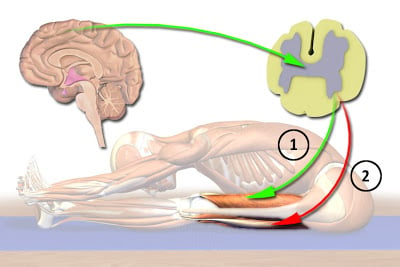
Do you remember when you first started driving? Even with an automatic transmission, I used 2 feet; one foot on the gas and one foot riding that brake pedal. It was obviously inefficient for me because I wasted energy by using 2 feet instead of 1, but it was also tough on the car trying to accelerate while simultaneously slowing down.
The human body operates in a similar way, the gas pedal is your prime movers, agonist muscles which contract to cause movement. While the brakes are antagonist muscles on the other side of the body that oppose the agonist’s movement. This agonist-antagonist pairing can be the key to enhancing your athletic efficiency and sequencing, you just have to learn to drive with the brake off
It is always best to start with the nervous system, where the signals to these muscles actually begin. The process of reciprocal inhibition occurs when the central nervous system sends a message to the agonist muscle to contract, but the tension in the antagonist muscle is inhibited by impulses from motor neurons, and thus must simultaneously relax.
in the picture above, #1 is the Quadriceps which pull you forward to touch your toes (agonist muscles), while #2 is the Hamstrings (antagonists) that simultaneously relax to allow the agonist to work more efficiently
One of the best ways to enhance reciprocal inhibition is to just train correctly. Studies have shown that higher trained athletes show less antagonist activity in movement, which makes sense when we see the relaxed appearance of a higher quality execution.
Another great research discovery in trained athletes is the reduction of antagonist activity with fatigue. Basically the body becomes more efficient as it gets tired.

A December 2011 study out of Denmark examined the relationship between antagonist muscle activity and trigger points, tender spots within a muscle. These trigger points have been linked to muscle cramps, restricted range of motion, muscle weakness, and fatigue.
Previously, pain has been found to increase antagonistic activity, which makes sense. After all, if the body is trying to protect itself from driving fast, you should keep your foot on the brakes. This study revealed that the neurons innervating these trigger points are just very excited, contributing to the reduced efficiency of reciprocal inhibition, or altered reciprocal inhibition.
Ibarra JM, Ge HY, Wang C, Martínez Vizcaíno V, Graven-Nielsen T, Arendt-Nielsen L. Latent myofascial trigger points are associated with an increased antagonistic muscle activity during agonist muscle contraction. J Pain. 2011 Dec;12(12):1282-8. Epub 2011 Nov 11.